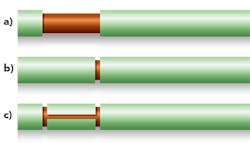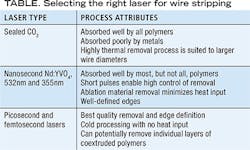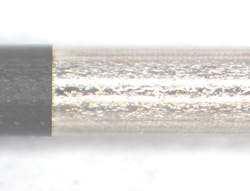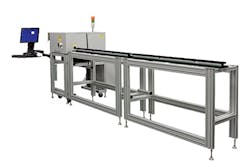Laser stripping for the medical and electronics industries
Many wires and cables used in medical device and electronics applications require stripping outer layers of polymers from small-diameter wire, and the laser is well suited for this material removal task. The laser offers tailored removal strategies for wire ends and mid-wire sections and windows, providing a non-contact process that is very repeatable. The easily automated laser transforms a key step in the manufacturing process, providing consistent part quality.
Additional advantages of using lasers rather than chemical-based processes include safety benefits from eliminating chemical use, reduction of chemical handling and disposal costs, and support for a company's ISO 14001 sustainability program.
Lasers for wire stripping
In medical device manufacturing, many cardiac rhythm management, neurological, and radio frequency ablation products require material removal to expose a wire's underlying metal conductor. The diameter of wires used for these devices is constantly decreasing, making other stripping methods simply untenable. At the same time, wire stripping requirements are constantly increasing, with both end- and mid-span parts requiring selective removal. Similarly, in electronics, size reduction of wires and increasing wire density in cables aligns well with laser wire stripping.
The laser process imparts no physical force on the wire during the process, so delicate wires with diameters as small as 50μm can be stripped. The material is typically removed by directing a focused beam (around 25μm in diameter) by galvanometers, which are small, fully programmable x and y mirrors. This enables highly tailored removal, so parts or sections of wire insulation can be removed as needed. Changes to the size and location of the removed sections can be made on the fly by calling up pre-programmed recipes.
The material is removed by one of two methods: ablation or cut and peel (FIGURE 1). The ablation method simply removes all the material from the wire as the polymer absorbs the light energy and is vaporized—effectively ejected away from wire. The laser does not affect the wire beneath the insulation because the power levels needed to remove the insulation are much lower than those that would damage the metal wire. This advantage can be augmented by selecting a laser wavelength that is readily absorbed by the polymers, but reflected by the wire. With the cut and peel method, a series of helical cuts in the insulation are made that mechanically free the insulation from the wire (not always possible), which is removed post-process by automated or manual means. This is typically done when the cycle time is critical and post-process material removal is acceptable.
Laser vs. other wire-stripping methods
For wire stripping, the benefits of using the laser's highly controlled, direct-removal approach must be contrasted with chemical and mechanical processes currently being used.
In the medical device industry, due to the relative lower volume compared to electronics, the most common process is manually based. This process includes dipping each wire individually into a solvent for a certain amount of time and then manually scraping any remaining coating material deposits with a sharp knife—the X-ACTO method. Quality and repeatability is hardly assured using this process. Moving away from technicians wielding X-ACTO knives to automated pieces of equipment increases production process control, ensures quality, and increases throughput.
For example, one large medical device company recently transitioned from a manual to a laser process for producing stainless steel guidewires used in intravascular interventional devices. The wire, with a diameter similar to that of a human hair, is coated with an organic material that makes it compatible for use in humans. This organic coating material must then be stripped away from the microscopic metal core wire to enable connection to the guidewire's distal end.
The new laser process consistently and precisely strips away the organic material coating from the component's metal core wire, which enables subsequent assembly operations performed to the unit in downstream processes. Far less operator-dependent than the method it replaces, the new process takes only seconds to complete, whereas the previous process took about 8 min. Throughput rose by 250 percent, with an additional increase in yield.
In electronics, the higher volume of parts dictate automated removal techniques; however, the basic premise is that the same—either chemical, mechanical, or a combination of both—can be used. As wire diameters decrease, there is less control of insulation removal of these processes, with potential issues of damaging the conductor and wire deformation.
Picking the right laser
A number of different lasers can be used for wire stripping, depending upon the particular wire diameter, insulation material (polyimide, Pebax, polyethylene terephthalate [PET], nylon, fluoropolymers, and PVC), and feature requirements. The TABLE shows the lasers most commonly used for wire stripping, listed by suggested order of consideration, from top to bottom. For each combination of material, wire diameter, and required features, there is a suitable laser that matches the desired criteria.
The removal of the material is done more by thermal degradation, so heat input can be an issue if the wire diameter is small. This may result in wire distortion and potential cutting or the insulation can be overheated, causing discoloration and burr formation. (A burr develops when the material bulges or is raised, and can significantly increase the overall wire outer diameter.)
If a CO2 laser cannot be used for reasons of heat input control, the nanosecond laser should be considered next, specifically those with 532 and 355nm wavelengths. Nanosecond lasers produce pulses of around 20ns, removing wire insulation material with much less thermal interaction than that of the CO2 laser. It can be used on smaller-diameter wires, or where the removal edge must be well-defined with little or no burr. FIGURE 3 shows a wire that has been stripped using a nanosecond laser with a wavelength of 355 nm.The choice between 532 or 355nm is typically made based upon the insulation material, with the 355nm being better absorbed by more polymers. If the CO2 laser is likened to a large oxyacetylene blow torch, the nanosecond later would be analogous to a smaller, more delicate torch that might be used for finishing off a crème brûlée.
Note that the popular fiber laser operating at 1070nm is not well absorbed by most of the typical wire insulation materials, and so it is rarely used or considered.
When extreme quality or minimal heat input is needed, the options to consider are ultrafast picosecond and femtosecond lasers. These two laser families produce pulse widths that are extremely short: picoseconds are 10–12 s and femtoseconds are 10–15 s. The pulses are so short that the material does not have time to conduct any heat from the process area into the surrounding material.
This so-called "cold processing" enables the best-quality results, but such a high-quality level comes at a steep price. Ultrafast lasers cost about 25 times more than CO2 lasers, and about 5 times that of a 532/355 nm laser. They may be appropriate for very high-value products or for those with extremely small wires (50μm in diameter), where very fine control is needed.
Laser wire stripping systems
In medical device manufacturing, the wires are typically part of a production line. They are not usually processed in reel-to-reel machines; rather, they are processed in either a manual or automated load machine that handles the wire pieces one at a time at the required length.
Essentially, the wire stripper can either rotate the wire or use multiple heads to remove the insulation from the stationary wire. Sometimes the process, rather than the manufacturing environment, dictates which of these techniques is used. As always, the best solution is based on a clear understanding of both the application and production needs.
FIGURE 4 shows a laser ablation system recently developed by Amada Miyachi America, which includes high-speed galvo beam steering and a custom wire feed and rotating mechanism that achieves accurate and repeatable wire positioning. Also included are several proprietary features needed to manage heat balance in the part during the ablation process; the features facilitate clean removal of the insulation material, while fully protecting the delicate metal wire substrate.This approach also includes a self-cleaning mechanism that removes sticky debris from the ablation process area that might have contaminated tooling. In effect, the system has a dual cleaning process: the vacuum on the laser itself, along with a high-tech "toothbrush" that mechanically cleans the tooling after every operation. This self-cleaning feature allows tens of thousands of wires to be run with minimal scheduled maintenance.
Use of lasers for wire stripping transforms a key step in the process to a lean operation. The key to the success of wire stripping processes is the development of the process itself. To make the right decision on which laser source and removal methodology works best, it is absolutely essential to test possible options in an application laboratory with a range of lasers. The resulting system solution will then be optimal in both process and implementation.
About the Author
Geoff Shannon, Ph.D.
Director Strategic Marketing for Precision Manufacturing, Coherent
Geoff Shannon, Ph.D., is Director Strategic Marketing for Precision Manufacturing at Coherent (Santa Clara, CA) and an Editorial Advisor to Industrial Laser Solutions. He previously served as Laser Technology Manager for Miyachi Unitek, specializing in the development of lasers and applications for existing and new markets. Shannon has a BEng in Mechanical Engineering and PhD in Laser Welding Technology from the University of Liverpool. His 20-year career in laser technology has centered around applications research and development and new product development of lasers and systems.




